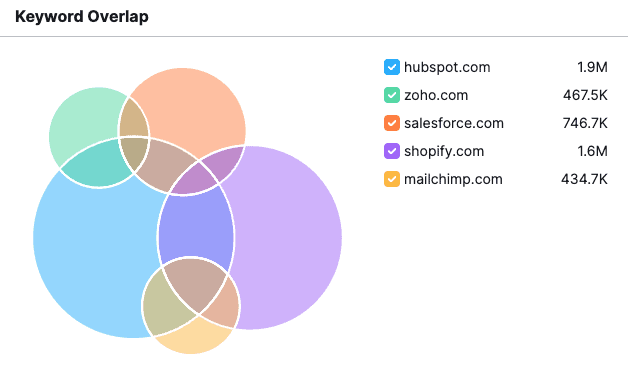One of the strongest SEO signals you can give Google to understand what your website should rank for is topical authority.
Topical authority is essentially demonstrating subject matter expertise, and it is achieved by covering everything there is to cover about the topics you want to rank for.
Conducting a content gap analysis is a great way to identify opportunities to improve your existing content, as well as brand new content angles related to your service and product offering.
This can help you expand your topical authority and improve your SEO rankings.
In this article, you’ll learn what a content gap analysis is, why you should regularly do one, and how to do a content gap analysis using SEO tools.
Let’s dive in.
What Is A Content Gap Analysis?
A content gap analysis identifies content topics and keywords your competitors are outperforming your website for and provides insights into how you can improve your own content.
There are two types of content gaps:
- Site wide gap: these are the content topics your competitors cover on their websites, but you don’t. Depending on your service and product offering versus those of your competitors, it may or may not make sense to cover these topics on your website.
- Single page gap: you and a competitor both cover the same topic, but your competitor covers the topic better and/or more comprehensively than you do, and ranks higher for the target keywords as a result.
Why You Should Regularly Do A Content Gap Analysis
A content gap analysis should not be a one-off thing, but should ideally be done regularly in order to stay on top of what your competitors are doing.
Here’s the benefits of regular content gap analyses:
- It helps identify outdated content. Content freshness can be a ranking factor for some queries, and if competitors overtake your rankings, it could mean their content is fresher. You should fact check your content and include more recent insights and sources where possible. TIP: Use Google’s Search Analytics for Sheets add-on in order to gain more insights into exactly which keywords have dropped over time.
- It helps spot content topics that should be made more evergreen and better meet the search intent of the keywords. If all of your competitors are ranking on the first page with a listicle article, then that is the content type Google is looking for. It may mean you need to change your content format.
- It helps generate brand new content ideas and angles you may not have thought of. Ask yourself why your competitors are targeting certain keywords you are not targeting at all, and whether these are ideas relevant to your target customers and worth pursuing.
When you do this regularly – such as quarterly – you are much better positioned to stay on top of your competitors’ strategies and beat them.
How To Do A Competitor Content Gap Analysis
There are several SEO tools on the market that can help you do a competitor content gap analysis.
In this example, we are using SEMRush to analyze the content gap between HubSpot and some of their competitors.

The high level overview illustrates that HubSpot has a keyword overlap with several of their competitors. Some competitors have an overlap with each other, and each competitor has a set of keywords only they rank for.
It makes sense for each website to rank for keywords none of the others rank for, as this overview includes their branded keywords and each of the companies included is targeting slightly different business verticals and audiences.
Now let’s look at a set of keywords HubSpot doesn’t rank for at all, but their competitors do:

These are topics that may be interesting for HubSpot to publish new pieces of content about in order to get closer to the topical coverage of their competitors.
Here’s another view, where we filtered on keywords HubSpot ranks in the top 50 for, and all competitors rank better for.

The fact HubSpot already ranks in the top 50 likely means the keyword is interesting for them and somewhat related to the page that ranks.
But each of the competitors ranks better, indicating that HubSpot may need to improve their content in order to compete.
These are excellent keywords for HubSpot to analyze further and see if there are ways to optimize their existing pages to become better than the competition.
How To Improve Your Content Against The Current Page 1 on Google
Let’s take a look at the keyword “customer acquisition” using SEMRush.

This is an example keyword where HubSpot is beating their competition, as they are currently in 2nd place only behind Amazon. Shopify also ranks on the first page, while Mailchimp and Zoho are not quite there yet with 19th and 24th place rankings, respectively.
Let’s see what the first page looks like for this keyword.

There is a very clear pattern in the top 8 (marked in green): they are all “what is” explainer articles and guides that explain what customer acquisition is. HubSpot and Shopify have articles that nail the search intent.
Results 9 and 10 are slightly different, as they talk about customer acquisition cost. And this trend continues on to the 2nd and 3rd page, which also includes Mailchimp’s and Zoho’s articles about customer acquisition cost.


Further analysis shows us that “customer acquisition” and “customer acquisition cost” are very closely related and sometimes even used interchangeably, but they are not exactly the same thing.
Google is clearly looking for different information and article formats for both keywords.
We can illustrate this further by looking at the first page for “customer acquisition cost”:

HubSpot is ranking for this keyword too, but with a different, dedicated page.
Out of the competitors analyzed in this example, HubSpot is the only website that tackles both keywords with two dedicated pages, whereas the other websites have only one page that targets both keywords.
It may be a good idea for Zoho and Mailchimp to follow this best practice and publish dedicated pages for the keywords instead.
This is a clear example of the types of insights you can get from a content gap analysis, and how it can lead to actionable ideas to improve your website and SEO.
Get Started With Analyzing Your Content Today
Competitor analysis should be a fundamental part of your SEO strategy, and a content gap analysis should be one of your first steps in order to understand where you currently stand and what is needed to bridge the gap.
We recommend using SEMRush to get started, as it provides excellent insights into where your content can be improved compared to your competitors.
Recommended Content SEO Tools
These SEO Tools can to provide great insights to help you create great website content that includes best practice SEO at a low price with just a monthly commitment
-
SEM Rush - The best value SEO tool for content gap analysis.SEM Rush - The best value SEO tool for content gap analysis.
-
Surfer SEO - Enables you gain a content SEO score analyse of competitor pages ranking in the top 10 of Google and also write new content whilst being provided with an SEO score.Surfer SEO - Enables you gain a content SEO score analyse of competitor pages ranking in the top 10 of Google and also write new content whilst being provided with an SEO score.
-
Writesonic - Chat GPT4 AI writing software, from as little as 19 USD per month that writes new articles for you, whilst integrating SEO keywords and can also re-write content for you, amongst many other things.Writesonic - Chat GPT4 AI writing software, from as little as 19 USD per month that writes new articles for you, whilst integrating SEO keywords and can also re-write content for you, amongst many other things.
-
KeySearch - A great value keyword research tools that provides you with keyword insights across many different search engines and countries at just 17 USD per month.KeySearch - A great value keyword research tools that provides you with keyword insights across many different search engines and countries at just 17 USD per month.
Taksu Digital provides tailored SEO services and we can help you set up, streamline and execute a content gap analysis. Contact us to help us understand how we can help you grow.
Disclaimer: In our content we may include recommendation links to other products and services that we may earn affiliate commissions on (with no extra cost to you, the reader).





